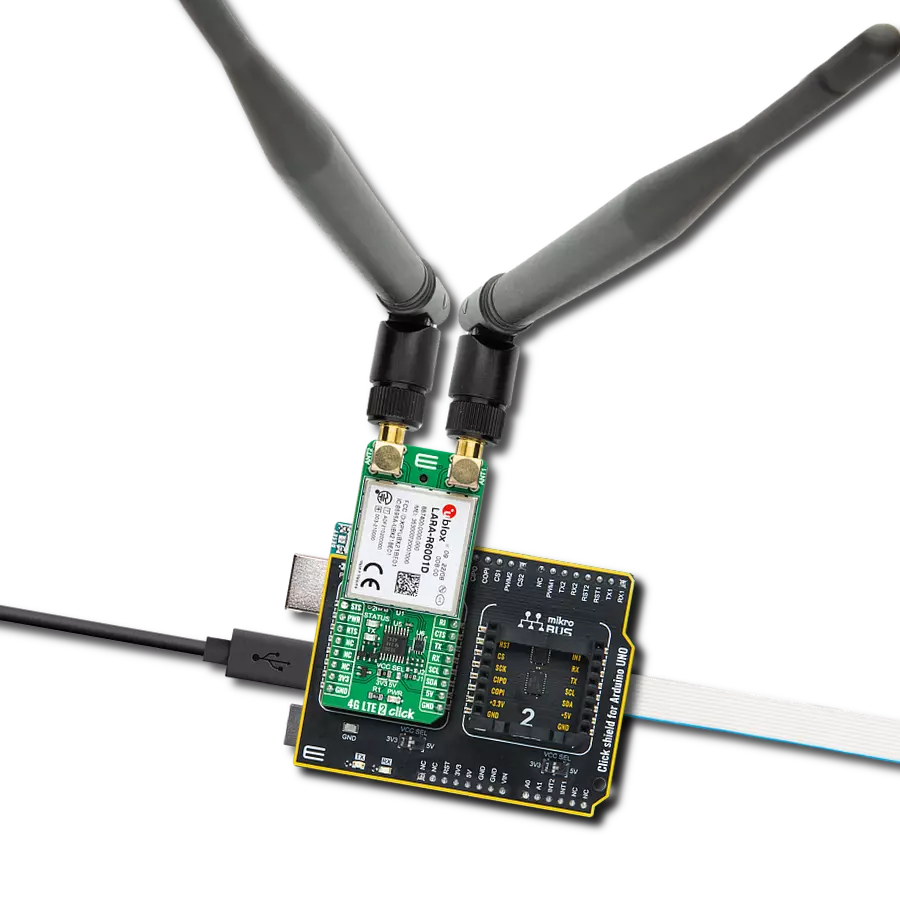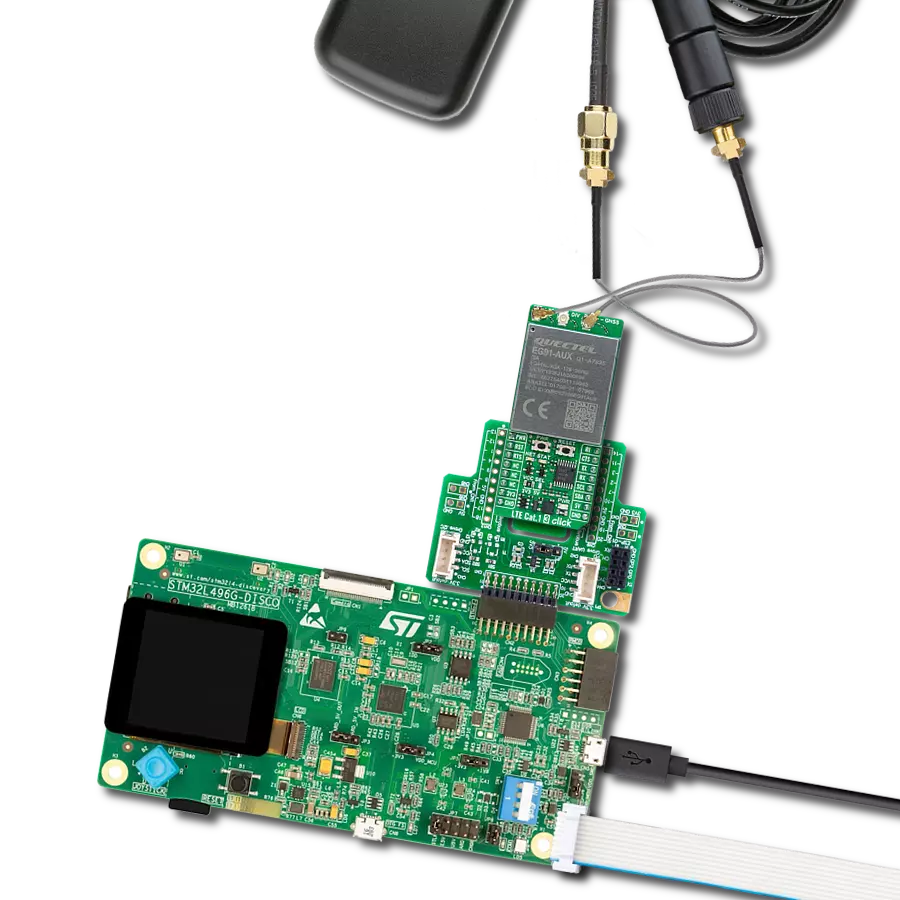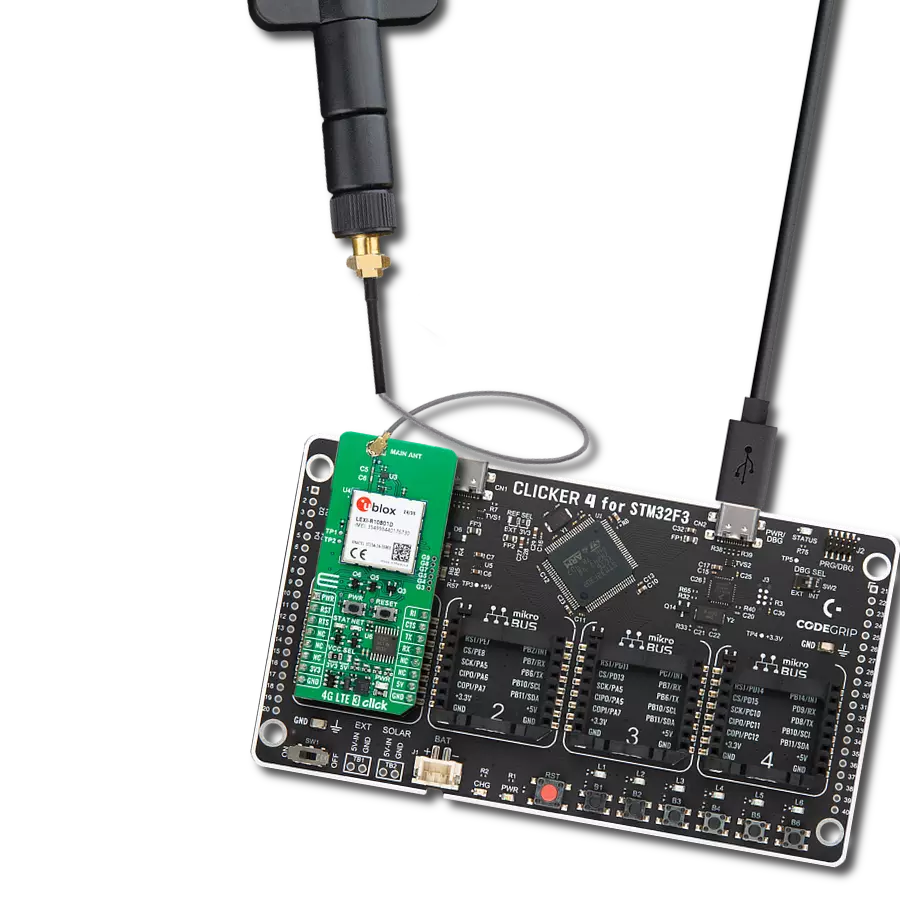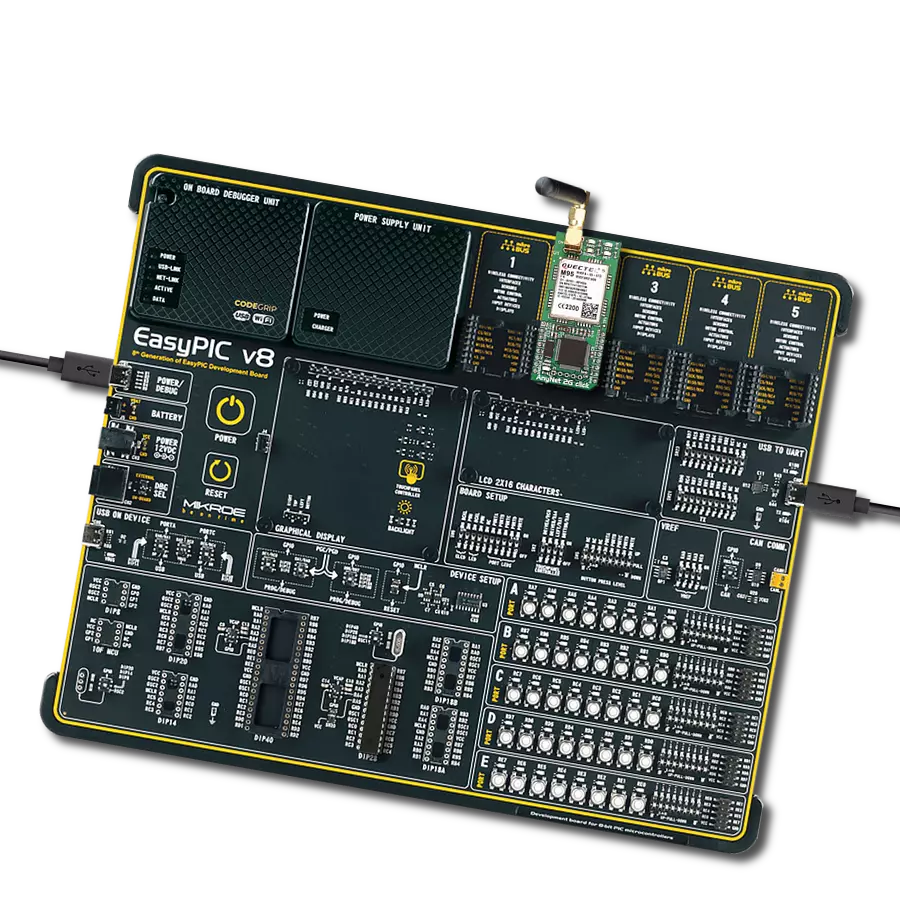Global coverage secure-cloud data-only solution
A
A
Hardware Overview
How does it work?
4G LTE 2 Click is based on the LARA-R6001D from u-blox, a multi-band and multi-mode module supporting LTE Cat 1 FDD and LTE Cat 1 TDD radio access technology (18 LTE bands), with 3G UMTS/HSPA and 2G GSM/GPRS/EGPRS fallback, providing the ideal solution for uncompromised global connectivity. This Click board™ represents a data-only solution with worldwide coverage and all relevant MNO certifications, offering great flexibility except for the support of voice/audio applications. Versatile interfaces and features make the LARA-R6001D ideally suited for a wide range of applications that require medium data speed, superior coverage, and streaming data like asset tracking, telematics, remote monitoring, point-of-sale terminals, and more. This module requires a 3.8V power supply. Therefore, the Click board™ incorporates an integrated buck (step-down DC-DC) converter, the TPS7A7002 by Texas Instruments, which provides a stable 3.8V power supply, capable of mitigating voltage drops at the input when a high current peak appears (typically at the StartUp of the device). The module Ignition
(Power-On) pin, labeled as PWR and routed to the RST pin on the mikroBUS™ socket, enables power to be switched on and off. The LARA-R6001D communicates with an MCU using the UART interface with commonly used UART RX and TX pins with the hardware flow control pins UART CTS, RTS, RI (Clear to Send, Ready to Send, and Ring Indicator). It operates at 115200 bps by default configuration to transmit and exchange data with the host MCU through AT commands that u-blox provides. Besides the UART interface, the LARA-R6001D also provides the possibility of using the I2C interface as an I2C host, which can communicate with I2C local devices via the I2C bus specifications. This Click board™ is also equipped with a USB type C connector for diagnostic purposes only, where the module acts as a USB device and can be connected to any USB host equipped with compatible drivers. Among its used pins, this Click board™ also possesses two additional LED indicators: the yellow LED labeled as STATUS, routed both to the mikroBUS™ AN pin (STS) The LTE cellular networks use spatial
multiplexing antenna technology, allowing more than one antenna to be used for better reception. For that reason, besides the primary and the LED, used to indicate the status of the network connection visually, and a red LED labeled as TX used to tell the transmitting status of the module. TX/RX antenna, this Click board™ uses a secondary diversity RX antenna, which allows better signal reception. Alongside the SMA connectors, the 4G LTE 2 Click also has a Nano-SIM card slot that provides multiple connections and interface options alongside several test points labeled from TP1 to TP3, enabling easy reboot and testing of the module. This Click board™ can operate with either 3.3V or 5V logic voltage levels selected via the VCC SEL jumper. This way, both 3.3V and 5V capable MCUs can use the communication lines properly. However, the Click board™ comes equipped with a library containing easy-to-use functions and an example code that can be used, as a reference, for further development.

Features overview
Development board
Arduino UNO is a versatile microcontroller board built around the ATmega328P chip. It offers extensive connectivity options for various projects, featuring 14 digital input/output pins, six of which are PWM-capable, along with six analog inputs. Its core components include a 16MHz ceramic resonator, a USB connection, a power jack, an
ICSP header, and a reset button, providing everything necessary to power and program the board. The Uno is ready to go, whether connected to a computer via USB or powered by an AC-to-DC adapter or battery. As the first USB Arduino board, it serves as the benchmark for the Arduino platform, with "Uno" symbolizing its status as the
first in a series. This name choice, meaning "one" in Italian, commemorates the launch of Arduino Software (IDE) 1.0. Initially introduced alongside version 1.0 of the Arduino Software (IDE), the Uno has since become the foundational model for subsequent Arduino releases, embodying the platform's evolution.
Microcontroller Overview
MCU Card / MCU
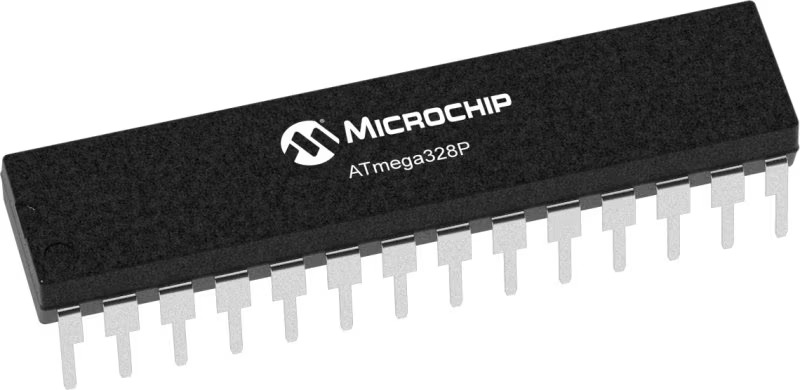
Architecture
AVR
MCU Memory (KB)
32
Silicon Vendor
Microchip
Pin count
28
RAM (Bytes)
2048
You complete me!
Accessories
Click Shield for Arduino UNO has two proprietary mikroBUS™ sockets, allowing all the Click board™ devices to be interfaced with the Arduino UNO board without effort. The Arduino Uno, a microcontroller board based on the ATmega328P, provides an affordable and flexible way for users to try out new concepts and build prototypes with the ATmega328P microcontroller from various combinations of performance, power consumption, and features. The Arduino Uno has 14 digital input/output pins (of which six can be used as PWM outputs), six analog inputs, a 16 MHz ceramic resonator (CSTCE16M0V53-R0), a USB connection, a power jack, an ICSP header, and reset button. Most of the ATmega328P microcontroller pins are brought to the IO pins on the left and right edge of the board, which are then connected to two existing mikroBUS™ sockets. This Click Shield also has several switches that perform functions such as selecting the logic levels of analog signals on mikroBUS™ sockets and selecting logic voltage levels of the mikroBUS™ sockets themselves. Besides, the user is offered the possibility of using any Click board™ with the help of existing bidirectional level-shifting voltage translators, regardless of whether the Click board™ operates at a 3.3V or 5V logic voltage level. Once you connect the Arduino UNO board with our Click Shield for Arduino UNO, you can access hundreds of Click boards™, working with 3.3V or 5V logic voltage levels.
This multiband LTE Rubber Antenna with adjustable angle is an excellent choice for all 3G/4G LTE-based click boards from our offer, as well as other devices that require excellent throughput on all major cellular bands worldwide. The antenna has an SMA male connector, which allows it to be mounted directly on the Click board™ or the female SMA module connector. The antenna position can be adjusted in 45⁰ increments (0⁰/45⁰/90⁰).
Used MCU Pins
mikroBUS™ mapper
Take a closer look
Click board™ Schematic

Step by step
Project assembly
Track your results in real time
Application Output
1. Application Output - In Debug mode, the 'Application Output' window enables real-time data monitoring, offering direct insight into execution results. Ensure proper data display by configuring the environment correctly using the provided tutorial.

2. UART Terminal - Use the UART Terminal to monitor data transmission via a USB to UART converter, allowing direct communication between the Click board™ and your development system. Configure the baud rate and other serial settings according to your project's requirements to ensure proper functionality. For step-by-step setup instructions, refer to the provided tutorial.

3. Plot Output - The Plot feature offers a powerful way to visualize real-time sensor data, enabling trend analysis, debugging, and comparison of multiple data points. To set it up correctly, follow the provided tutorial, which includes a step-by-step example of using the Plot feature to display Click board™ readings. To use the Plot feature in your code, use the function: plot(*insert_graph_name*, variable_name);. This is a general format, and it is up to the user to replace 'insert_graph_name' with the actual graph name and 'variable_name' with the parameter to be displayed.

Software Support
Library Description
This library contains API for 4G LTE 2 Data Click driver.
Key functions:
c4glte2data_set_power_stateThis function sets a desired power state by toggling the PWR pin with a specific time for a high state.c4glte2data_set_sim_apnThis function sets APN for a sim card.c4glte2data_send_sms_textThis function sends a text message to a phone number.
Open Source
Code example
The complete application code and a ready-to-use project are available through the NECTO Studio Package Manager for direct installation in the NECTO Studio. The application code can also be found on the MIKROE GitHub account.
/*!
* @file main.c
* @brief 4G LTE 2 Data Click Example.
*
* # Description
* Application example shows device capability of connecting to the network and
* sending SMS or TCP/UDP messages using standard "AT" commands.
*
* The demo application is composed of two sections :
*
* ## Application Init
* Initializes the driver, restarts the module and tests the communication.
*
* ## Application Task
* Application task is split in few stages:
* - C4GLTE2DATA_CONFIGURE_FOR_NETWORK:
* Sets configuration to device to be able to connect to the network.
*
* - C4GLTE2DATA_WAIT_FOR_CONNECTION:
* Waits for the network registration indicated via CREG URC event and then checks the connection status.
*
* - C4GLTE2DATA_CONFIGURE_FOR_EXAMPLE:
* Sets the device configuration for sending SMS or TCP/UDP messages depending on the selected demo example.
*
* - C4GLTE2DATA_EXAMPLE:
* Depending on the selected demo example, it sends an SMS message (in PDU or TXT mode) or TCP/UDP message.
*
* By default, the TCP/UDP example is selected.
*
* ## Additional Function
* - static void c4glte2data_clear_app_buf ( void )
* - static err_t c4glte2data_process ( void )
* - static void c4glte2data_error_check( err_t error_flag )
* - static void c4glte2data_log_app_buf ( void )
* - static err_t c4glte2data_rsp_check ( void )
* - static err_t c4glte2data_configure_for_network( void )
* - static err_t c4glte2data_check_connection( void )
* - static err_t c4glte2data_configure_for_example( void )
* - static err_t c4glte2data_example( void )
*
* @note
* In order for the examples to work, user needs to set the APN and SMSC (SMS PDU mode only)
* of entered SIM card as well as the phone number (SMS mode only) to which he wants to send an SMS.
* Enter valid values for the following macros: SIM_APN, SIM_SMSC and PHONE_NUMBER_TO_MESSAGE.
* Example:
SIM_APN "internet"
SIM_SMSC "+381610401"
PHONE_NUMBER_TO_MESSAGE "+381659999999"
*
* @author Stefan Filipovic
*
*/
#include "board.h"
#include "log.h"
#include "c4glte2data.h"
#include "generic_pointer.h"
#include "conversions.h"
// Example selection macros
#define EXAMPLE_TCP_UDP 0 // Example of sending messages to a TCP/UDP echo server
#define EXAMPLE_SMS 1 // Example of sending SMS to a phone number
#define DEMO_EXAMPLE EXAMPLE_TCP_UDP // Example selection macro
// SIM APN config
#define SIM_APN "" // Set valid SIM APN
// SMS example parameters
#define SIM_SMSC "" // Set valid SMS Service Center Address - only in SMS PDU mode
#define PHONE_NUMBER_TO_MESSAGE "" // Set Phone number to message
#define SMS_MODE "1" // SMS mode: "0" - PDU, "1" - TXT
// TCP/UDP example parameters
#define REMOTE_IP "77.46.162.162" // TCP/UDP echo server IP address
#define REMOTE_PORT "51111" // TCP/UDP echo server port
// Message content
#define MESSAGE_CONTENT "4G LTE 2 Data Click board - demo example."
// Application buffer size
#define PROCESS_BUFFER_SIZE 300
/**
* @brief Example states.
* @details Predefined enum values for application example state.
*/
typedef enum
{
C4GLTE2DATA_CONFIGURE_FOR_NETWORK = 1,
C4GLTE2DATA_WAIT_FOR_CONNECTION,
C4GLTE2DATA_CONFIGURE_FOR_EXAMPLE,
C4GLTE2DATA_EXAMPLE
} c4glte2data_example_state_t;
static c4glte2data_t c4glte2data;
static log_t logger;
/**
* @brief Application example variables.
* @details Variables used in application example.
*/
static char app_buf[ PROCESS_BUFFER_SIZE ] = { 0 };
static int32_t app_buf_len = 0;
static int32_t app_buf_cnt = 0;
static err_t error_flag;
static c4glte2data_example_state_t example_state;
/**
* @brief Clearing application buffer.
* @details This function clears memory of application
* buffer and reset its length and counter.
*/
static void c4glte2data_clear_app_buf ( void );
/**
* @brief Data reading function.
* @details This function reads data from device and
* appends it to the application buffer.
* @return @li @c 0 - Some data is read.
* @li @c -1 - Nothing is read.
* See #err_t definition for detailed explanation.
*/
static err_t c4glte2data_process ( void );
/**
* @brief Check for errors.
* @details This function checks for different types of
* errors and logs them on UART or logs the response if no errors occured.
*/
static void c4glte2data_error_check( err_t error_flag );
/**
* @brief Logs application buffer.
* @details This function logs data from application buffer.
*/
static void c4glte2data_log_app_buf ( void );
/**
* @brief Response check.
* @details This function checks for response and
* returns the status of response.
* @return @li @c 0 - OK response.
* @li @c -2 - Timeout error.
* @li @c -3 - Command error.
* @li @c -4 - Unknown error.
* See #err_t definition for detailed explanation.
*/
static err_t c4glte2data_rsp_check ( void );
/**
* @brief Configure device for connection to the network.
* @details Sends commands to configure and enable
* connection to the specified network.
* @return @li @c 0 - OK response.
* @li @c -2 - Timeout error.
* @li @c -3 - Command error.
* @li @c -4 - Unknown error.
* See #err_t definition for detailed explanation.
*/
static err_t c4glte2data_configure_for_network( void );
/**
* @brief Wait for connection signal.
* @details Wait for connection signal from CREG URC.
* @return @li @c 0 - OK response.
* @li @c -2 - Timeout error.
* @li @c -3 - Command error.
* @li @c -4 - Unknown error.
* See #err_t definition for detailed explanation.
*/
static err_t c4glte2data_check_connection( void );
/**
* @brief Configure device for example.
* @details Configure device for the specified example.
* @return @li @c 0 - OK response.
* @li @c -2 - Timeout error.
* @li @c -3 - Command error.
* @li @c -4 - Unknown error.
* See #err_t definition for detailed explanation.
*/
static err_t c4glte2data_configure_for_example( void );
/**
* @brief Execute example.
* @details This function executes SMS or TCP/UDP example depending on the DEMO_EXAMPLE macro.
* @return @li @c 0 - OK response.
* @li @c -2 - Timeout error.
* @li @c -3 - Command error.
* @li @c -4 - Unknown error.
* See #err_t definition for detailed explanation.
*/
static err_t c4glte2data_example( void );
void application_init ( void )
{
log_cfg_t log_cfg; /**< Logger config object. */
c4glte2data_cfg_t c4glte2data_cfg; /**< Click config object. */
/**
* Logger initialization.
* Default baud rate: 115200
* Default log level: LOG_LEVEL_DEBUG
* @note If USB_UART_RX and USB_UART_TX
* are defined as HAL_PIN_NC, you will
* need to define them manually for log to work.
* See @b LOG_MAP_USB_UART macro definition for detailed explanation.
*/
LOG_MAP_USB_UART( log_cfg );
log_init( &logger, &log_cfg );
log_info( &logger, " Application Init " );
// Click initialization.
c4glte2data_cfg_setup( &c4glte2data_cfg );
C4GLTE2DATA_MAP_MIKROBUS( c4glte2data_cfg, MIKROBUS_1 );
if ( UART_ERROR == c4glte2data_init( &c4glte2data, &c4glte2data_cfg ) )
{
log_error( &logger, " Application Init Error. " );
log_info( &logger, " Please, run program again... " );
for ( ; ; );
}
c4glte2data_set_power_state ( &c4glte2data, C4GLTE2DATA_POWER_STATE_OFF );
c4glte2data_set_power_state ( &c4glte2data, C4GLTE2DATA_POWER_STATE_ON );
c4glte2data_process( );
c4glte2data_clear_app_buf( );
app_buf_len = 0;
app_buf_cnt = 0;
// Check communication
c4glte2data_send_cmd( &c4glte2data, C4GLTE2DATA_CMD_AT );
error_flag = c4glte2data_rsp_check( );
c4glte2data_error_check( error_flag );
log_info( &logger, " Application Task " );
example_state = C4GLTE2DATA_CONFIGURE_FOR_NETWORK;
}
void application_task ( void )
{
switch ( example_state )
{
case C4GLTE2DATA_CONFIGURE_FOR_NETWORK:
{
if ( C4GLTE2DATA_OK == c4glte2data_configure_for_network( ) )
{
example_state = C4GLTE2DATA_WAIT_FOR_CONNECTION;
}
break;
}
case C4GLTE2DATA_WAIT_FOR_CONNECTION:
{
if ( C4GLTE2DATA_OK == c4glte2data_check_connection( ) )
{
example_state = C4GLTE2DATA_CONFIGURE_FOR_EXAMPLE;
}
break;
}
case C4GLTE2DATA_CONFIGURE_FOR_EXAMPLE:
{
if ( C4GLTE2DATA_OK == c4glte2data_configure_for_example( ) )
{
example_state = C4GLTE2DATA_EXAMPLE;
}
break;
}
case C4GLTE2DATA_EXAMPLE:
{
c4glte2data_example( );
break;
}
default:
{
log_error( &logger, " Example state." );
break;
}
}
}
int main ( void )
{
/* Do not remove this line or clock might not be set correctly. */
#ifdef PREINIT_SUPPORTED
preinit();
#endif
application_init( );
for ( ; ; )
{
application_task( );
}
return 0;
}
static void c4glte2data_clear_app_buf ( void )
{
memset( app_buf, 0, app_buf_len );
app_buf_len = 0;
app_buf_cnt = 0;
}
static err_t c4glte2data_process ( void )
{
int32_t rx_size;
char rx_buff[ PROCESS_BUFFER_SIZE ] = { 0 };
rx_size = c4glte2data_generic_read( &c4glte2data, rx_buff, PROCESS_BUFFER_SIZE );
if ( rx_size > 0 )
{
int32_t buf_cnt = 0;
if ( ( app_buf_len + rx_size ) > PROCESS_BUFFER_SIZE )
{
c4glte2data_clear_app_buf( );
return C4GLTE2DATA_ERROR;
}
else
{
buf_cnt = app_buf_len;
app_buf_len += rx_size;
}
for ( int32_t rx_cnt = 0; rx_cnt < rx_size; rx_cnt++ )
{
if ( rx_buff[ rx_cnt ] != 0 )
{
app_buf[ ( buf_cnt + rx_cnt ) ] = rx_buff[ rx_cnt ];
}
else
{
app_buf_len--;
buf_cnt--;
}
}
return C4GLTE2DATA_OK;
}
return C4GLTE2DATA_ERROR;
}
static err_t c4glte2data_rsp_check ( void )
{
uint32_t timeout_cnt = 0;
uint32_t timeout = 120000;
err_t error_flag = c4glte2data_process( );
if ( ( C4GLTE2DATA_OK != error_flag ) && ( C4GLTE2DATA_ERROR != error_flag ) )
{
return error_flag;
}
while ( ( 0 == strstr( app_buf, C4GLTE2DATA_RSP_OK ) ) &&
( 0 == strstr( app_buf, C4GLTE2DATA_RSP_ERROR ) ) )
{
error_flag = c4glte2data_process( );
if ( ( C4GLTE2DATA_OK != error_flag ) && ( C4GLTE2DATA_ERROR != error_flag ) )
{
return error_flag;
}
if ( timeout_cnt++ > timeout )
{
c4glte2data_clear_app_buf( );
return C4GLTE2DATA_ERROR_TIMEOUT;
}
Delay_ms ( 1 );
}
if ( strstr( app_buf, C4GLTE2DATA_RSP_OK ) )
{
return C4GLTE2DATA_OK;
}
else if ( strstr( app_buf, C4GLTE2DATA_RSP_ERROR ) )
{
return C4GLTE2DATA_ERROR_CMD;
}
else
{
return C4GLTE2DATA_ERROR_UNKNOWN;
}
}
static void c4glte2data_error_check( err_t error_flag )
{
switch ( error_flag )
{
case C4GLTE2DATA_OK:
{
c4glte2data_log_app_buf( );
break;
}
case C4GLTE2DATA_ERROR:
{
log_error( &logger, " Overflow!" );
break;
}
case C4GLTE2DATA_ERROR_TIMEOUT:
{
log_error( &logger, " Timeout!" );
break;
}
case C4GLTE2DATA_ERROR_CMD:
{
log_error( &logger, " CMD!" );
break;
}
case C4GLTE2DATA_ERROR_UNKNOWN:
default:
{
log_error( &logger, " Unknown!" );
break;
}
}
c4glte2data_clear_app_buf( );
Delay_ms ( 500 );
}
static void c4glte2data_log_app_buf ( void )
{
for ( int32_t buf_cnt = 0; buf_cnt < app_buf_len; buf_cnt++ )
{
log_printf( &logger, "%c", app_buf[ buf_cnt ] );
}
}
static err_t c4glte2data_configure_for_network( void )
{
err_t func_error = C4GLTE2DATA_OK;
// Deregister from network
#define DEREGISTER_FROM_NETWORK "2"
c4glte2data_send_cmd_with_parameter( &c4glte2data, C4GLTE2DATA_CMD_COPS, DEREGISTER_FROM_NETWORK );
error_flag = c4glte2data_rsp_check();
func_error |= error_flag;
c4glte2data_error_check( error_flag );
// Set SIM APN
c4glte2data_set_sim_apn( &c4glte2data, SIM_APN );
error_flag = c4glte2data_rsp_check();
func_error |= error_flag;
c4glte2data_error_check( error_flag );
// Enable full functionality
#define FULL_FUNCTIONALITY "1"
c4glte2data_send_cmd_with_parameter( &c4glte2data, C4GLTE2DATA_CMD_CFUN, FULL_FUNCTIONALITY );
error_flag = c4glte2data_rsp_check();
func_error |= error_flag;
c4glte2data_error_check( error_flag );
// Automatic registration
#define AUTOMATIC_REGISTRATION "0"
c4glte2data_send_cmd_with_parameter( &c4glte2data, C4GLTE2DATA_CMD_COPS, AUTOMATIC_REGISTRATION );
error_flag = c4glte2data_rsp_check();
func_error |= error_flag;
c4glte2data_error_check( error_flag );
// Enable network registartion
#define ENABLE_REG "2"
c4glte2data_send_cmd_with_parameter( &c4glte2data, C4GLTE2DATA_CMD_CREG, ENABLE_REG );
error_flag = c4glte2data_rsp_check();
func_error |= error_flag;
c4glte2data_error_check( error_flag );
return func_error;
}
static err_t c4glte2data_check_connection( void )
{
#define CONNECTED "+CREG: 1"
c4glte2data_process( );
if ( strstr( app_buf, CONNECTED ) )
{
Delay_ms ( 100 );
c4glte2data_process( );
c4glte2data_log_app_buf( );
log_printf( &logger, "\r\n" );
c4glte2data_clear_app_buf( );
// Check signal quality
c4glte2data_send_cmd( &c4glte2data, C4GLTE2DATA_CMD_CSQ );
error_flag = c4glte2data_rsp_check( );
c4glte2data_error_check( error_flag );
return error_flag;
}
return C4GLTE2DATA_ERROR;
}
static err_t c4glte2data_configure_for_example( void )
{
err_t func_error = C4GLTE2DATA_OK;
#if ( DEMO_EXAMPLE == EXAMPLE_TCP_UDP )
#define ACTIVATE_PDP_CONTEXT "1,1"
c4glte2data_send_cmd_with_parameter( &c4glte2data, C4GLTE2DATA_CMD_CGACT, ACTIVATE_PDP_CONTEXT );
error_flag = c4glte2data_rsp_check( );
func_error |= error_flag;
c4glte2data_error_check( error_flag );
#elif ( DEMO_EXAMPLE == EXAMPLE_SMS )
c4glte2data_send_cmd_with_parameter( &c4glte2data, C4GLTE2DATA_CMD_CMGF, SMS_MODE );
error_flag = c4glte2data_rsp_check( );
func_error |= error_flag;
c4glte2data_error_check( error_flag );
#else
#error "No demo example selected"
#endif
return func_error;
}
static err_t c4glte2data_example( void )
{
err_t func_error = C4GLTE2DATA_OK;
#if ( DEMO_EXAMPLE == EXAMPLE_TCP_UDP )
char cmd_buf[ 100 ] = { 0 };
char urc_buf[ 20 ] = { 0 };
uint16_t timeout_cnt = 0;
uint16_t timeout = 30000;
uint8_t * __generic_ptr socket_num_buf = 0;
uint8_t tcp_socket_num[ 2 ] = { 0 };
uint8_t udp_socket_num[ 2 ] = { 0 };
// Create TCP socket
#define RSP_USOCR "+USOCR: "
#define TCP_PROTOCOL "6"
c4glte2data_send_cmd_with_parameter( &c4glte2data, C4GLTE2DATA_CMD_USOCR, TCP_PROTOCOL );
error_flag = c4glte2data_rsp_check( );
func_error |= error_flag;
socket_num_buf = strstr( app_buf, RSP_USOCR ) + strlen ( RSP_USOCR );
tcp_socket_num[ 0 ] = *socket_num_buf;
c4glte2data_error_check( error_flag );
// Create UDP socket
#define UDP_PROTOCOL "17"
c4glte2data_send_cmd_with_parameter( &c4glte2data, C4GLTE2DATA_CMD_USOCR, UDP_PROTOCOL );
error_flag = c4glte2data_rsp_check( );
func_error |= error_flag;
socket_num_buf = strstr( app_buf, RSP_USOCR ) + strlen ( RSP_USOCR );
udp_socket_num[ 0 ] = *socket_num_buf;
c4glte2data_error_check( error_flag );
// Connect TCP socket to remote IP and port
strcpy( cmd_buf, tcp_socket_num );
strcat( cmd_buf, ",\"" );
strcat( cmd_buf, REMOTE_IP );
strcat( cmd_buf, "\"," );
strcat( cmd_buf, REMOTE_PORT );
c4glte2data_send_cmd_with_parameter( &c4glte2data, C4GLTE2DATA_CMD_USOCO, cmd_buf );
error_flag = c4glte2data_rsp_check( );
func_error |= error_flag;
c4glte2data_error_check( error_flag );
// Connect UDP socket to remote IP and port
strcpy( cmd_buf, udp_socket_num );
strcat( cmd_buf, ",\"" );
strcat( cmd_buf, REMOTE_IP );
strcat( cmd_buf, "\"," );
strcat( cmd_buf, REMOTE_PORT );
c4glte2data_send_cmd_with_parameter( &c4glte2data, C4GLTE2DATA_CMD_USOCO, cmd_buf );
error_flag = c4glte2data_rsp_check( );
func_error |= error_flag;
c4glte2data_error_check( error_flag );
// Get message length
uint8_t message_len_buf[ 5 ] = { 0 };
uint16_t message_len = strlen( MESSAGE_CONTENT );
uint16_to_str( message_len, message_len_buf );
l_trim( message_len_buf );
r_trim( message_len_buf );
// Write message to TCP socket
strcpy( cmd_buf, tcp_socket_num );
strcat( cmd_buf, "," );
strcat( cmd_buf, message_len_buf );
strcat( cmd_buf, ",\"" );
strcat( cmd_buf, MESSAGE_CONTENT );
strcat( cmd_buf, "\"" );
c4glte2data_send_cmd_with_parameter( &c4glte2data, C4GLTE2DATA_CMD_USOWR, cmd_buf );
error_flag = c4glte2data_rsp_check( );
func_error |= error_flag;
c4glte2data_error_check( error_flag );
// Read response message from TCP socket
#define URC_READ_SOCKET_DATA_TCP "+UUSORD: "
strcpy( urc_buf, URC_READ_SOCKET_DATA_TCP );
strcat( urc_buf, tcp_socket_num );
for ( ; ; )
{
c4glte2data_process( );
uint8_t * __generic_ptr start_response_buf = strstr( app_buf, urc_buf );
if ( start_response_buf )
{
Delay_ms ( 100 );
c4glte2data_process( );
uint8_t response_len_buf[ 5 ] = { 0 };
char * __generic_ptr start_response_len = strstr( start_response_buf, "," ) + 1;
memcpy ( response_len_buf, start_response_len, app_buf_len - ( start_response_len - app_buf ) );
strcpy( cmd_buf, tcp_socket_num );
strcat( cmd_buf, "," );
strcat( cmd_buf, response_len_buf );
c4glte2data_log_app_buf( );
c4glte2data_clear_app_buf( );
c4glte2data_send_cmd_with_parameter( &c4glte2data, C4GLTE2DATA_CMD_USORD, cmd_buf );
error_flag = c4glte2data_rsp_check( );
func_error |= error_flag;
c4glte2data_error_check( error_flag );
break;
}
if ( timeout_cnt++ > timeout )
{
break;
}
Delay_ms ( 1 );
}
timeout_cnt = 0;
// Write message to UDP socket
strcpy( cmd_buf, udp_socket_num );
strcat( cmd_buf, "," );
strcat( cmd_buf, message_len_buf );
strcat( cmd_buf, ",\"" );
strcat( cmd_buf, MESSAGE_CONTENT );
strcat( cmd_buf, "\"" );
c4glte2data_send_cmd_with_parameter( &c4glte2data, C4GLTE2DATA_CMD_USOWR, cmd_buf );
error_flag = c4glte2data_rsp_check( );
func_error |= error_flag;
c4glte2data_error_check( error_flag );
// Read response message from UDP socket
#define URC_READ_SOCKET_DATA_UDP "+UUSORD: "
strcpy( urc_buf, URC_READ_SOCKET_DATA_UDP );
strcat( urc_buf, udp_socket_num );
for ( ; ; )
{
c4glte2data_process( );
uint8_t * __generic_ptr start_response_buf = strstr( app_buf, urc_buf );
if ( start_response_buf )
{
Delay_ms ( 100 );
c4glte2data_process( );
uint8_t response_len_buf[ 5 ] = { 0 };
char * __generic_ptr start_response_len = strstr( start_response_buf, "," ) + 1;
memcpy ( response_len_buf, start_response_len, app_buf_len - ( start_response_len - app_buf ) );
strcpy( cmd_buf, udp_socket_num );
strcat( cmd_buf, "," );
strcat( cmd_buf, response_len_buf );
c4glte2data_log_app_buf( );
c4glte2data_clear_app_buf( );
c4glte2data_send_cmd_with_parameter( &c4glte2data, C4GLTE2DATA_CMD_USORD, cmd_buf );
error_flag = c4glte2data_rsp_check( );
func_error |= error_flag;
c4glte2data_error_check( error_flag );
break;
}
if ( timeout_cnt++ > timeout )
{
break;
}
Delay_ms ( 1 );
}
// Close TCP socket
c4glte2data_send_cmd_with_parameter( &c4glte2data, C4GLTE2DATA_CMD_USOCL, tcp_socket_num );
error_flag = c4glte2data_rsp_check( );
func_error |= error_flag;
c4glte2data_error_check( error_flag );
// Close UDP socket
c4glte2data_send_cmd_with_parameter( &c4glte2data, C4GLTE2DATA_CMD_USOCL, udp_socket_num );
error_flag = c4glte2data_rsp_check( );
func_error |= error_flag;
c4glte2data_error_check( error_flag );
Delay_ms ( 1000 );
Delay_ms ( 1000 );
Delay_ms ( 1000 );
Delay_ms ( 1000 );
Delay_ms ( 1000 );
#elif ( DEMO_EXAMPLE == EXAMPLE_SMS )
// Check SMS mode
#define CMGF_PDU "+CMGF: 0"
#define CMGF_TXT "+CMGF: 1"
c4glte2data_send_cmd_check( &c4glte2data, C4GLTE2DATA_CMD_CMGF );
error_flag = c4glte2data_rsp_check( );
func_error |= error_flag;
if ( strstr( app_buf, CMGF_PDU ) )
{
c4glte2data_error_check( error_flag );
// Send SMS in PDU mode
c4glte2data_send_sms_pdu( &c4glte2data, SIM_SMSC, PHONE_NUMBER_TO_MESSAGE, MESSAGE_CONTENT );
error_flag = c4glte2data_rsp_check( );
func_error |= error_flag;
}
else if ( strstr( app_buf, CMGF_TXT ) )
{
c4glte2data_error_check( error_flag );
// Send SMS in TXT mode
c4glte2data_send_sms_text ( &c4glte2data, PHONE_NUMBER_TO_MESSAGE, MESSAGE_CONTENT );
error_flag = c4glte2data_rsp_check( );
func_error |= error_flag;
}
c4glte2data_error_check( error_flag );
// 30 seconds delay
Delay_ms ( 1000 );
Delay_ms ( 1000 );
Delay_ms ( 1000 );
Delay_ms ( 1000 );
Delay_ms ( 1000 );
Delay_ms ( 1000 );
Delay_ms ( 1000 );
Delay_ms ( 1000 );
Delay_ms ( 1000 );
Delay_ms ( 1000 );
Delay_ms ( 1000 );
Delay_ms ( 1000 );
Delay_ms ( 1000 );
Delay_ms ( 1000 );
Delay_ms ( 1000 );
Delay_ms ( 1000 );
Delay_ms ( 1000 );
Delay_ms ( 1000 );
Delay_ms ( 1000 );
Delay_ms ( 1000 );
Delay_ms ( 1000 );
Delay_ms ( 1000 );
Delay_ms ( 1000 );
Delay_ms ( 1000 );
Delay_ms ( 1000 );
Delay_ms ( 1000 );
Delay_ms ( 1000 );
Delay_ms ( 1000 );
Delay_ms ( 1000 );
Delay_ms ( 1000 );
#else
#error "No demo example selected"
#endif
return func_error;
}
// ------------------------------------------------------------------------ END
Additional Support
Resources
Category:GSM/LTE
